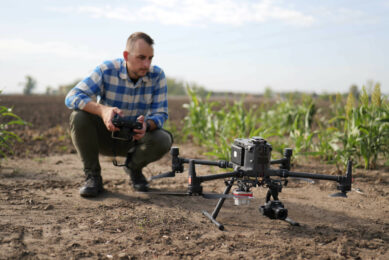Comparing knapsack, boom, and drone sprayers in soybean crops

A field experiment in India showed that drone sprayers can save on herbicide application time, water, and labour by up to 85%. According to the study, the drone sprayer exhibited exceptional work efficiency.
A field experiment in India showed that drone sprayers can save on herbicide application time, water, and labour by up to 85%. According to the study, the drone sprayer exhibited exceptional work efficiency.
The study titled, ‘Comparative Evaluation of Knapsack, Boom, and Drone Sprayers for Weed Management in Soybean (Glycine max L.)’ was carried out during the Kharif season 2021-22 at an experimental farm affiliated with the Department of Agronomy, Vasantrao Naik Marathwada Krishi Vidyapeeth, Parbhani.
Remarkable outcomes
The primary objective was to evaluate the comparative efficacy of various sprayers in controlling weeds in soybeans and their work efficiency. The Randomized Block Design (RBD) included ten treatments of pre-emergence (PE) and post-emergence (POE) herbicides applied by knapsack, boom, and drone sprayers.
The research team used a Quadcoptor type drone sprayer with a 10-litre tank capacity. The boom sprayer was a solar operated bullock drawn boom sprayer. Pendimethalin 30% EC @ 750 g a.i per ha was used for pre-emergence herbicide application, and Imazamox 35% EC + Imazethapyr 35% WG @ 70 g a.i per ha were used for post-emergence.
The investigative study unveiled remarkable outcomes in the realm of weed management within soybean cultivation. The employment of knapsack, boom, and drone sprayers for pre-emergence (PE) and post-emergence (POE) herbicide application was extensively explored.
Text continues below picture

Substantial reductions in water
The findings underscore the drone sprayer’s superiority in terms of time efficiency, reducing the time required for herbicide application by up to 99% compared to traditional methods. The requirement of time for the drone sprayer was 20 min per hectare. The flow rate was high, 3.5 litre/min and the speed was 4.5 metre per second, with a pressure of 3 bars.
The knapsack sprayer required 8 hours per ha. This may be due to the low flow rate of 0.9 litre/min with a pressure of 2.9 bars. The boom sprayer required 2 hours per ha. It used 5.5 litre/min.
The researchers also looked at the time hand-weeding took. The highest time requirement was observed in this weed-free treatment. The time required for one hand weeding pass was 20 hours per hectare, and the total was 60 hours/ha (for 3 times weeding).
The drone sprayer demonstrated substantial reductions in water. The water requirement for the drone sprayer was 25 litre per ha. This is because the size of droplets size in microns, which gives a precise effect. The water requirement for a knapsack sprayer was 625 litre per ha pre-emergence spraying, and 520 litre per ha for post-emergence spraying. The boom sprayer needed 660 litre per ha for pre-emergence spraying, and 560 litre per ha for post-emergence spraying.
Herbicide usage
Importantly, drone-based herbicide spraying displayed the potential for a 30% reduction in herbicide dose application, highlighting its viability for minimizing herbicide usage. The drone sprayer exhibited exceptional work efficiency, outperforming the boom and knapsack sprayers, positioning it as a valuable tool for weed detection and herbicide resistance reduction.
Notably, the knapsack sprayer exhibited the highest weed control efficiency, statistically equivalent to the drone sprayer, for both PE and POE treatments. Moreover, the knapsack sprayer yielded superior results in PE herbicide application, showcasing its efficacy in weed control.
In the assessment of weed control strategies, various parameters were scrutinized to evaluate their effectiveness. Firstly, weed count per square meter was examined. The weed-free condition (hand-weeding) exhibited the significantly lowest weed count at 20, 40, 60 days after sowing (DAS), and at the time of harvest.
Treatments involving the application of polyethylene (PE) and polyolefin elastomer (POE) herbicides via drone sprayers and knapsack sprayers demonstrated similar weed counts, and this parity underscores their efficacy in reducing weed populations. This observation underscores the potency of these treatments in mitigating weed proliferation.
Text continues below picture

Weed control efficiency
Additionally, the dry weight of the weeds at various stages of growth (20, 40, 60 days, and harvest) was assessed. Hand-weeding yielded significantly lower weed dry weights across these time points.
The treatment involving the application of PE and POE herbicides via drone sprayer was found to be equally effective as the knapsack sprayer application in reducing weed dry weight. This reduction in weed dry weight underscores the success of both knapsack and drone-based herbicide applications in achieving effective weed control.
Further evaluation of weed control efficiency (WCE) was conducted to assess the impact of different sprayers. The WCE (%) at 20, 40, 60 days, and harvest stages was significantly influenced by the application of PE and POE herbicides using knapsack, drone, and boom sprayers.
Herbicides via knapsack sprayers
However, the weed-free treatment exhibited a high WCE, which was on par with the application of PE and POE herbicides via knapsack sprayers. But the drone and boom sprayer applications were comparable in efficiency to the knapsack sprayer.
Furthermore, the weed index (WI) in soybean plants was evaluated, with the weed-free treatment displaying the lowest and significantly superior WI. The application of herbicides via knapsack sprayers recorded the second-lowest WI, significantly outperforming the use of drones and boom sprayers.
The researchers say that the findings emphasise the significance of optimising spraying techniques to enhance soybean cultivation efficiency while aligning with sustainable development goals by mitigating environmental impacts associated with herbicide usage.
Join 17,000+ subscribers
Subscribe to our newsletter to stay updated about all the need-to-know content in the agricultural sector, two times a week.



